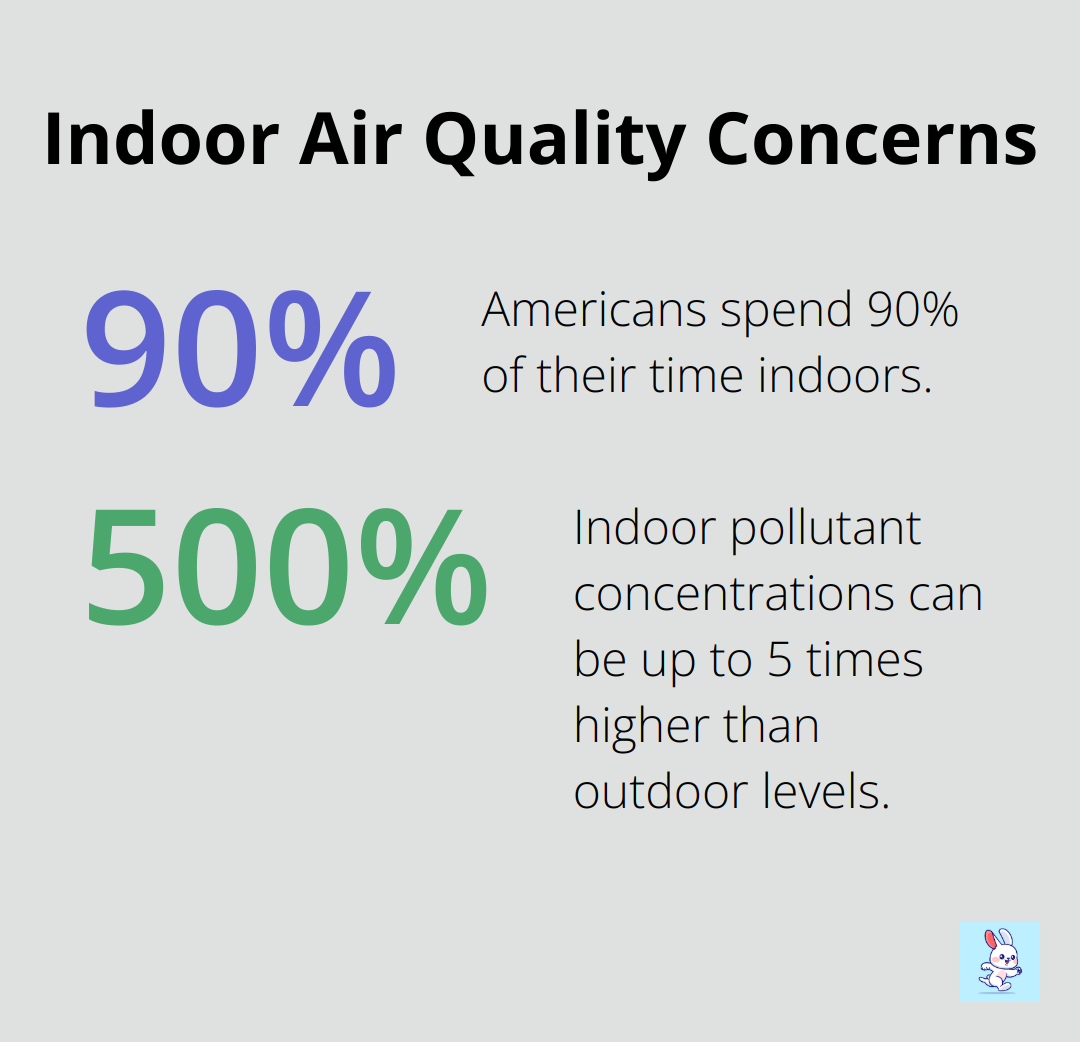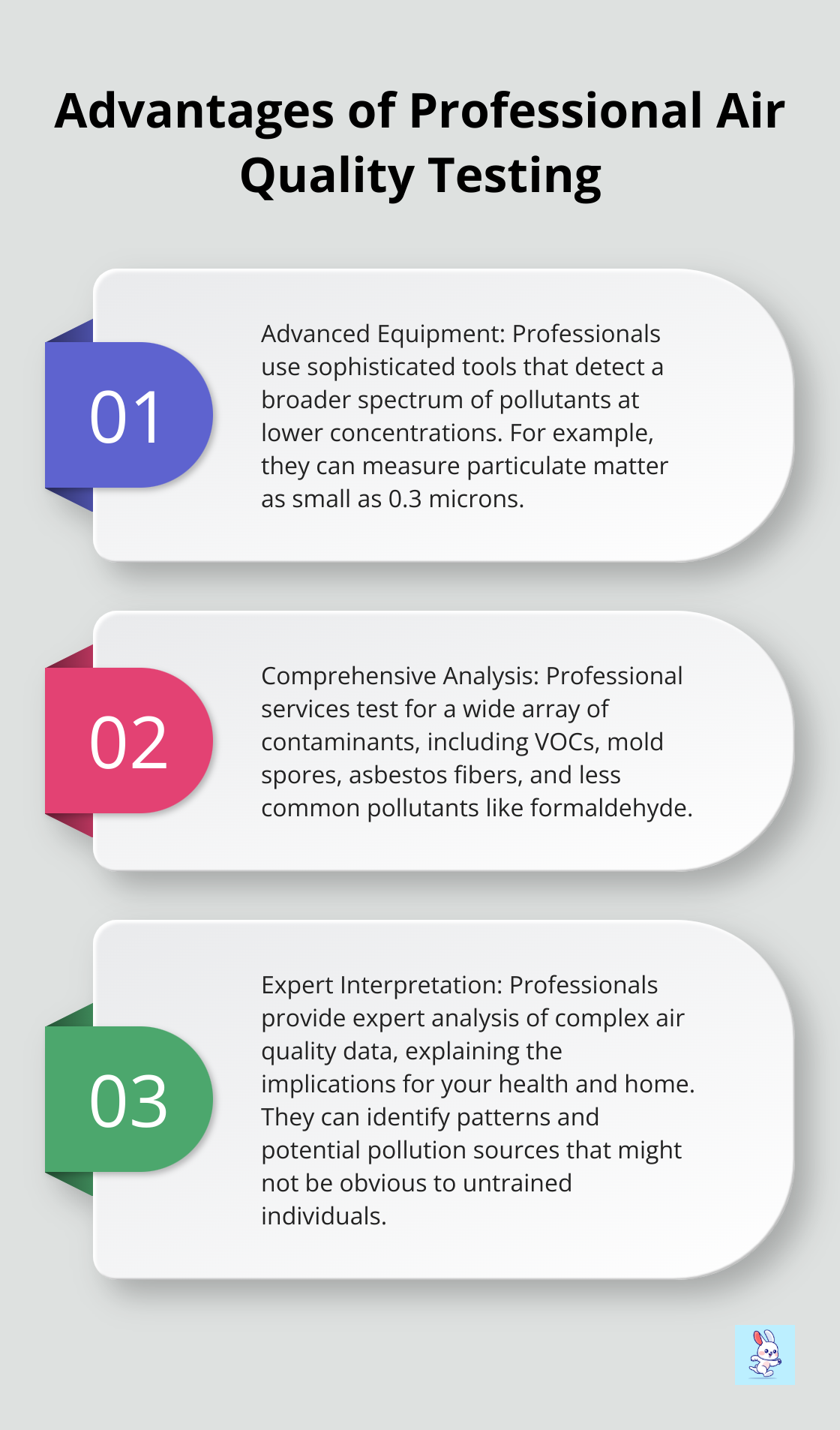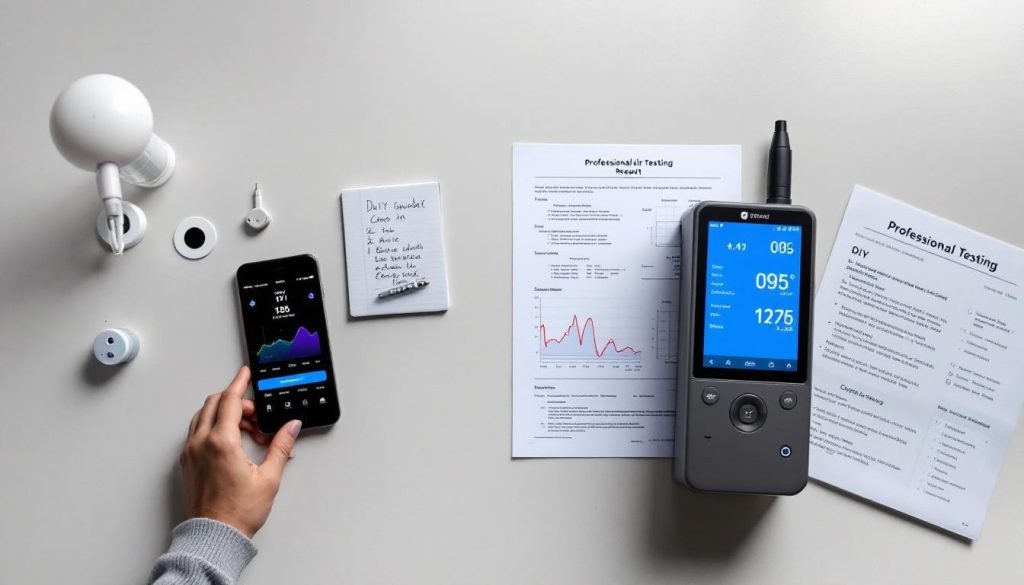At Cleaning Rabbit, we know that clean air is essential for a healthy home. Many homeowners are unsure whether to tackle air quality testing themselves or hire professionals.
This blog post will explore the pros and cons of DIY and professional air quality testing methods. We’ll help you decide which option is best for your home and family’s well-being.
What Is Air Quality Testing?
The Importance of Indoor Air Quality
Air quality testing identifies and measures pollutants in your home’s air. Poor air quality impacts health and comfort significantly. This process helps homeowners understand and improve their living environment.
Common Indoor Air Pollutants
Your home might contain various pollutants without your knowledge:
- Particulate Matter (PM2.5 and PM10): Tiny particles from dust, pollen, and smoke that penetrate deep into lungs.
- Volatile Organic Compounds (VOCs): Gases emitted from paints, cleaning products, and furniture.
- Carbon Monoxide (CO): A deadly, odorless gas produced by faulty heating systems or appliances.
- Radon: A radioactive gas that seeps into homes from the ground.
- Mold Spores: Fungi that thrive in damp environments and trigger allergies.
The Environmental Protection Agency (EPA) reports that Americans, on average, spend approximately 90 percent of their time indoors, where the concentrations of some pollutants are often 2 to 5 times higher than outdoor levels. This statistic highlights the need for regular testing.

The Testing Process
Air quality testing involves collecting air samples and analyzing them for various pollutants. Professional testing services use specialized equipment to measure pollutant levels accurately. This equipment ensures precise readings and comprehensive analysis.
Benefits of Regular Testing
Regular air quality assessments offer several advantages:
- Health Protection: Early identification of pollutants prevents respiratory issues, allergies, and more severe health problems.
- Energy Efficiency: Clean air systems operate more efficiently, potentially lowering energy bills.
- Property Value: Good air quality can increase your home’s market value.
The American Lung Association recommends professional radon testing, which costs range from $100 to $275 per unit for single-family housing.
Taking Action on Air Quality Issues
After identifying air quality issues, it’s time to act. This might involve:
- Improving ventilation
- Cleaning air ducts
- Addressing moisture problems
- Using air purifiers
While DIY testing kits are available, they often lack the accuracy and comprehensive analysis that professional services provide. For a thorough assessment of your home’s air quality, consider reaching out to experts who use advanced equipment and offer detailed analysis.
Now that we understand what air quality testing entails, let’s explore the different methods available for homeowners to assess their indoor air quality.
DIY Air Quality Testing: A Closer Look
Consumer-Grade Air Quality Test Kits
Hardware stores and online retailers offer DIY air quality test kits. These kits include test strips or collection devices for specific pollutants (mold, radon, or formaldehyde). Users collect samples and send them to a lab for analysis.
The EPA reports that radon test kits cost between $10 and $30, making them an affordable option for many homeowners. However, the accuracy of these kits varies widely depending on proper use and environmental factors.

Portable Air Quality Monitors
Portable air quality monitors have become more accessible, with some devices capable of monitoring multiple air-quality conditions such as CO2, VOCs, PM2.5 (fine particles), radon, and humidity.
While convenient, these monitors often lack the precision of professional-grade equipment. The American Lung Association cautions that consumer-grade monitors may not detect all harmful pollutants, potentially creating a false sense of security.
Advantages of DIY Testing
DIY air quality testing provides immediate results and can serve as a good starting point for understanding your home’s air quality. It’s particularly useful for detecting sudden changes or identifying obvious issues.
Limitations of DIY Methods
Interpreting results can challenge users without expert knowledge. The National Institute of Environmental Health Sciences works to understand how air pollution is associated with disease and how to prevent or reduce harm from exposures.
DIY methods may not capture the full picture of your indoor air quality. Professional testing services use more sophisticated equipment capable of detecting a wider range of pollutants at lower concentrations.
When to Consider Professional Testing
While DIY testing offers valuable insights, it shouldn’t replace professional assessments, especially if you suspect serious air quality issues or have specific health concerns. Professional air quality testing provides a comprehensive assessment and tailored solutions, which we’ll explore in the next section.
Why Professional Air Quality Testing Matters
Advanced Equipment for Precise Measurements
Professional air quality testing services utilize sophisticated equipment that surpasses consumer-grade devices in sensitivity and accuracy. These tools detect a broader spectrum of pollutants at significantly lower concentrations. Professional-grade particle counters, for instance, measure particulate matter as small as 0.3 microns (crucial for identifying potentially harmful fine dust and allergens).
The Environmental Protection Agency (EPA) recommends professional testing for certain pollutants like radon. Professional radon tests can detect levels as low as 0.3 picocuries per liter (pCi/L), while many DIY kits have a higher detection threshold.
Comprehensive Pollutant Analysis
Professional services conduct a thorough analysis of your home’s air, testing for a wide array of contaminants. This includes volatile organic compounds (VOCs), mold spores, asbestos fibers, and even less common pollutants like formaldehyde.
Expert Interpretation of Results
One of the most significant advantages of professional testing is the expertise in interpreting results. Air quality data can be complex, and understanding the implications for your health and home requires specialized knowledge. Professional testers don’t just provide raw numbers; they explain what those numbers mean for your specific situation. They can identify patterns and potential sources of pollution that might not be obvious to the untrained eye.

Customized Solutions and Recommendations
Based on their comprehensive analysis, professional air quality testers provide tailored recommendations for improving your home’s air quality. These solutions take into account factors like your home’s layout, ventilation system, and local climate. If high levels of VOCs are detected, a professional might recommend specific types of air purifiers or suggest changes to your home’s ventilation system. They can also advise on long-term strategies to maintain good air quality, such as regular HVAC maintenance or changes in cleaning products.
The American Lung Association emphasizes the importance of professional guidance in addressing air quality issues, noting that improper remediation can sometimes worsen the problem.
Final Thoughts
DIY air quality testing kits provide a quick snapshot of your home’s air quality. These kits work well for routine checks and initial assessments. Professional air quality testing offers superior accuracy, comprehensiveness, and expertise that DIY methods cannot match.
Professional testing becomes essential when you face persistent health issues or suspect serious pollutants. It also proves valuable after major renovations or when moving into a new home. Professional testers not only measure pollutants accurately but also interpret results and offer tailored solutions.
We at Cleaning Rabbit use advanced HEPA-filtered equipment for thorough air duct cleaning and HVAC sanitation. Our team provides comprehensive air quality assessments to enhance your home’s comfort and safety. Professional air quality testing represents an investment in your long-term health and well-being.

